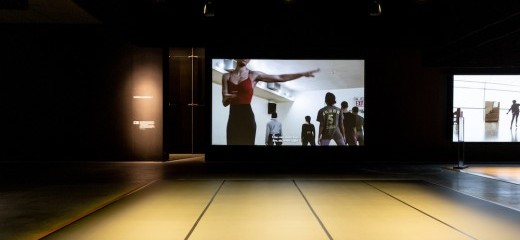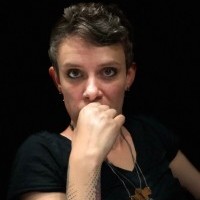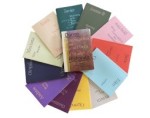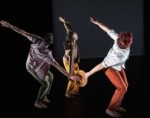
Floored
by Emilee Lord
The Trace of An Implied Presence is a multichannel video installation by visual artist, filmmaker, and curator Tiona Nekkia McClodden. It's a soft landing to enter the show. You walk in and adjust your eyes, read the wall text (or not), get pulled to one of the four screens, and tarry in a place. As with video installation, you could be anywhere in the story unfolding when you arrive. Or, in this case, five stories. The large projection screens are in a row and staggered further into the space by each one. A dance floor has been laid in front of each screen and softly lit. Two of these floors have a full length mirror in the corner. Maybe you get moved around the space by the voices of the other films. Perhaps the tap sounds call to you from the right corner. The gallery is low-lit and painted black.
The show is grounds for exploring and discovering contemporary Black dance's living history and influence. Based on McCLodden's research into Brooklyn Academy of Music's 1983 festival Dance Black America, the exhibition uses the voice of Mikki Shepard, the festival’s producer, as narrator in some places. Running through the gallery is a path to the back of the space, where you will find more small screens with archival footage and collections of texts on Black dancing bodies in America. Standing in this alcove, you are immersed in the artist's research process. The show highlights modern dance choreographer Leslie Cuyjet, Rod Rogers Dance Company, tap dancer Michael J. Love, and Philly Bop.
The films move back and forth between the artists speaking and dance footage, all in the same empty atrium-like space with a wooden floor. In the case of Audrey and June Donaldson and the Philly Bop community, McClodden added footage she filmed from these social gatherings. Each artist that McClodden studied unpacked their history with dance, their particular form, their ancestors within that form, and where Black and brown bodies were allowed to dance. And in each film, when they talked about access to or the use of dance space, they talked about the floor. To us as dancers, the physical relationship with the floor is paramount. There is much in this work about dance archives, a dance history not often included in the usual canon, and movement practice. It is tied together seamlessly and leaves a lot of room for personal experience within the themes of the work.
Each dance floor in front of the screens is appropriate for the dance style. Viewers receive this invitation from McClodden’s wall text, "whether professional or novice, you can come in and work something out within and outside your body." The invitation speaks to community and access. Dancers gain access to a place to practice in this city, and viewers become a part of the work. This conversation of access, allowance, permission, and power is held in the presence of the floors, in the feeling of the floors under your feet.
Throughout the run of this show (which closes December 11), there are live performances and social dances of the dance artists featured. You might also be lucky enough to be there on a day when one of the companies is rehearsing for their shows. According to the gallery attendants, many people outside these companies and scheduled works have accepted the invitation to move. While I heard about the activation of this space, my experience was quiet and solitary. I’d be interested in going a few more times to see how different the show can feel depending on who is there and who is moving.
There’s a lot of information here and a lot of different ways to be immersed in it. Maybe after you've watched and listened, you find the floor you like most, slip your shoes off, and dance through a moment in time. You are part of it.
The Trace of an Implied Presence, The Shed, NYC, Aug 3 - Dec 11 - see calendar for live performance dates
By Emilee Lord
October 24, 2022









